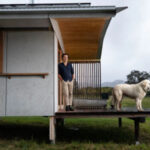Multigenerational push to drive housing prices to lower levels

LONDON: There is a growing view that lower priced green housing can only be achieved via prefabrication.
Many Australians are struggling to buy a new home, let alone one designed by a multi award-winning architect like Sydney’s Peter Stutchbury.
That could change if entrepreneur Oscar Martin can shake up the market for prefabricated green housing in the same way his former media company Pedestrian.TV stole the market for Millennials.
For the past two years, Martin has been working with Stutchbury and project manager Alejo De Achaval to build an affordable, prefabricated, carbon-neutral and concrete-free home with the aesthetics and flexibility of an architect-designed house.
The first home, a 90-square metre prototype called OM-1 by Martin and Stutchbury’s start-up Dimensions X, has been shortlisted for the NSW’s Australian Institute of Architects 2022 awards for sustainability and new houses.
“We’ve really tried hard to make the beautiful economical,” said Stutchbury. “That’s a very difficult thing to do.”
Martin adds: “We’re on a journey to create the world’s most planet-friendly sustainable architectural house.”
Rather than expecting buyers to adapt to a set design, Martin, Stutchbury and De Achaval have developed a prefabricated house with skylights that, like the house, can be rotated 360 degrees to suit a site. Windows and doors can be switched around. Walls can be removed because of a portal frame which means they aren’t load bearing.
Extra bays for desks, bedrooms, seating and storage pop out and add on.
Eaves are used for storage. The use of a new type of footing, a concrete-free foundation called Surefoot Footing, means the house can be located on any site – no matter how rocky, wet or hilly – with only minimal changes to its cost and little disruption to the land.
With walls made of cross laminated timber, the entire house arrives in a flat pack on a single truck, ready to be erected like a sturdy pack of cards in a few weeks, depending on size.
De Achaval hoped it would make home ownership more affordable.
“As a young person, buying a house is getting more unreachable,” said De Achaval, who is about to become a father for the first time. “Yet it feels like the only thing I can afford if I buy land is a prefab. Most seem like a temporary solution, and not a home.”
He said maybe the time had come for modern prefabricated houses, especially given an increased appetite for greener and more affordable housing.
Stutchbury said he had often been asked to design a prefabricated prototype. When he met Martin, he felt confident that he was someone who would take on the “sustainability, the aesthetic, the rigour – and who had the energy to do that.”
Martin developed an interest in building after selling Pedestrian.TV to the Nine Entertainment Co. (the owner of this masthead) in 2015.
He decided to knock down what had been the worst house in Bondi, and build a new one while undertaking a building diploma. The expense and waste led him to research pre-fabricated houses.
He discovered beautiful models in Scandinavia and Japan. Yet there was nothing to compare in Australia. “Everything I looked at was literally a rectangle on a concrete box. Massively destructive to the environment, nothing was flexible, and it didn’t reflect the site,” he said.
- Alejo de Achaval and Oscar Martin with the prefab kit home







